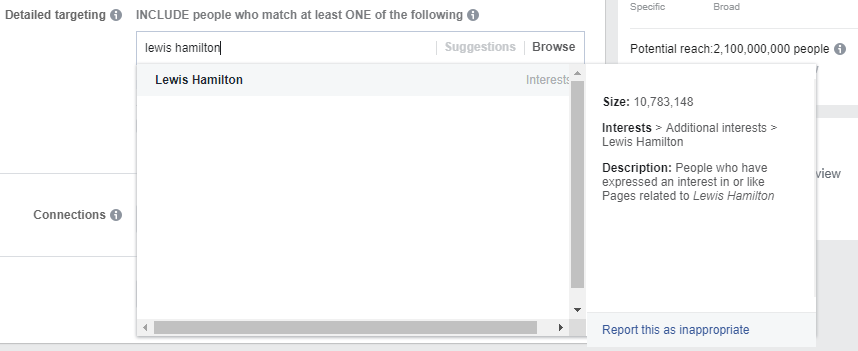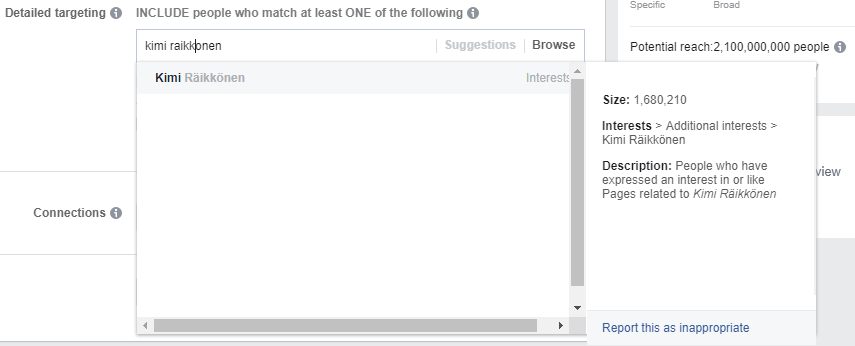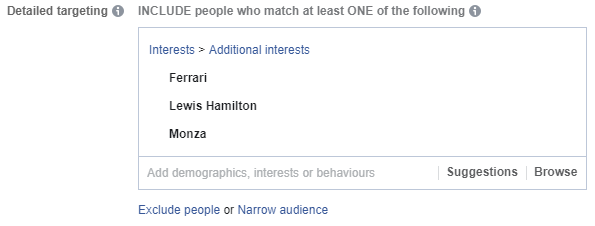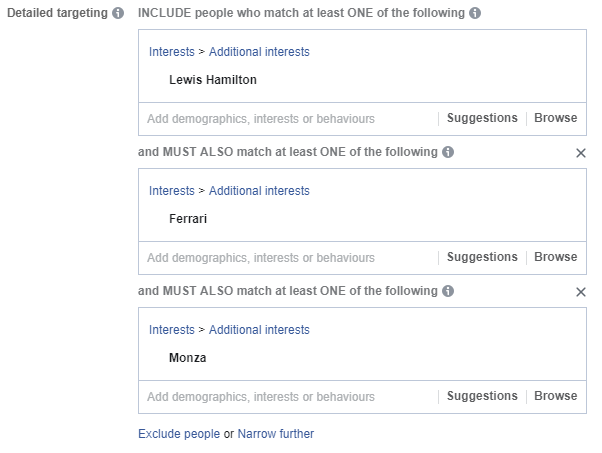
Facebook Targeting
How to Use Advanced Facebook Interest Targeting
At this point, we don’t need to lay it on any thicker. Facebook is the ultimate marketing platform. You know this is the case by now. We can roll out the same old stats:
- 38 billion users
- 56 billion daily users
- Facebook’s ad revenue was $16.6 billion for the final quarter of last year
- Etcetera, etcetera.
You already know that the huge numbers using Facebook, combined with the pinpoint accurate targeting features that the platform offers make it a space with huge potential.
“There is no other platform that matches Facebook in terms of the way that it can increase the exposure of your brand to people who will have a genuine interest in your industry.”
Done right, Facebook advertising is by far the best way to establish awareness in your brand and encourage sales. But often, it’s not done right. You can’t simply create an ad with a sloppy headline, an uninspiring image and format and wait for the sales to roll in.
 This goes for Facebook’s targeting abilities as well. They need to be done day and age, you can’t just target ‘right’. Every business worth its salt is making use of Facebook targeting to show their ads to the right users. You need to go a step further here.
This goes for Facebook’s targeting abilities as well. They need to be done day and age, you can’t just target ‘right’. Every business worth its salt is making use of Facebook targeting to show their ads to the right users. You need to go a step further here.
Targeting by interest is a good place to start. Showing your ads to users who have expressed an interest, intentionally or otherwise, in something related to your product. Again, this is a concept most businesses embarking on a Facebook advertising campaign will be aware of. That’s why we’ve created this blog. To show you some advanced ways in which you can utilise Facebook’s interest targeting abilities to ensure your ads only get shown to that top 1% of relevant users. So let’s see how you can outperform your competitors and get your ads in front of the most engaged pairs of eyes out of 2.38 billion.
Start with Your Buyer Persona
This is a concept you’re probably familiar with, but the fact is you can’t even effectively target, let alone target by interest, without an established buyer persona.
“Just in case you are unfamiliar with the term ‘buyer persona’, it essentially encompasses the concept of an ‘ideal customer’. You take the person who your product is aimed at and build up their attributes.”

How old are they? Where are they from? What’s their occupation? What are their interests?
Once you’ve answered these questions, you’ve created your buyer persona, the person to keep in mind in all your marketing endeavours. It is this buyer persona that allows you to target your Facebook ads in the first place.
When you’re establishing the age, the gender and location that your ad should be shown to, you use your buyer persona to dictate how you target. The next level is interest targeting.
Basic Interest Targeting
Facebook provides you with the ability to get your ads shown to people who have expressed a certain interest in something. Facebook has thousands of data points on its users.
Every time you like, share, comment, click on, or even stop scrolling on something, Facebook registers it. It takes every one of these actions into account to build up an unbelievably accurate picture of every single Facebook user.

So, when you’re building your ad, you can dictate what interests your audience will have. For example, let’s say you’ve created an ad for your engine cleaner that you sell. You could target this ad at people with an interest in cars, motorsport, engineering, those kinds of things.
Say you picked motorsport, then your ad would only be shown to those interested in motorsport. Of course, this is a far more relevant audience who will be more likely to buy your engine cleaner.
“But you didn’t come here for this basic interest targeting, this example was just designed to demonstrate how interest targeting actually works if this is a new concept to you.”
Let’s now take a look at how you can go beyond simply attaching a single interest to your ad, to get the very most out of Facebook’s abilities.
How Interests are Determined
From what we’ve already discussed, you should understand that Facebook is a pretty intelligent platform. Facebook doesn’t just look at the pages you’ve liked and take these to be your interests.
Of course, it does take this into account. If a user likes a page about Formula One, you can be pretty sure they’re a motoring enthusiast. But as we already mentioned, Facebook doesn’t just use this as the only indication of interest. Your comments, your likes on individual posts, the ads you’ve clicked… They all work to build up the picture of what you will likely be interested in. For that reason, the number of users that are included in interest targeting groups are far larger than you might expect.

For example, the number of users that are ‘interested’ in Formula One will far exceed the number of users that like Formula One Facebook pages. What does this mean for your advertising?
“There are positives and negatives that stem from this. The positive outcome is that your overall targeted audience extends beyond a simple group that likes a page. There is more potential that users who are still interested in your product, but don’t like a specific page, will see your ad.”
On the other hand, this target audience will now be so large that realistically, you’re not going to hit the most relevant users. A huge number of people may see your ad who aren’t actually that keen on Formula One, they have simply expressed some small amount of interest in it at some point.
This is where your advanced interest tactics will come into play…
Specific Interests Get Sales
When you choose your audience’s interest, you need to be sure that you’re specific. As we just mentioned, the fact that interest groups contain so many users means you’ll end up with a lot of irrelevant pairs of eyes looking at your ads, meaning wasted adspend for you.
“This means you need to think about your niche in depth. What would people that only have a real interest in your chosen field know about?”
To put this into an example, let’s say you want to find those people who are really, genuinely interested in Formula One. You’ve thought about using Formula One as the specified interest, but that’s got you a target audience of 87 million – clearly too large.

You might consider using a Formula One driver. Say you pick Lewis Hamilton, your audience size will decrease, but as he’s a personality known outside of just Formula One, you may still capture users that aren’t particularly interested in the sport.

So, you’ve got to dig deeper. This is your niche after all, you should know about things that no one but those with a genuine interest in Formula One would know about. You could, for example, use a more obscure driver. If we take a look at the size of the audience we get when we use Kimi Räikkönen as our interest, the audience falls to 1.6 million. Of course, when you apply all of your other targeting features: location, age, gender… then your audience will be smaller.

And the best bit? You know for a fact that this audience is going to have an interest in Formula One. Anyone that has expressed an interest in a relatively unknown Formula One driver will surely have an interest in the sport itself.
Think of things that you would know about, and people with real interest in your niche would know about, but others wouldn’t. And this is your first advanced Facebook interest targeting strategy.
Remember: It’s a Bidding War
You’re fighting with other companies for ad space. Always keep this in mind. If you go for the really obvious interests, the chances are you’ll be fighting against a number of different businesses trying to target the same people. You need to be a little bit more intelligent than this. If you’re a digital marketing company, don’t go targeting the interest ‘digital marketing’ as you’ll end up lost in the crowd of businesses also aiming their ads at people with the same broad interest.
“Spend time considering what those with an interest in digital marketing might also have interests in. For example, in our Formula One example we specified that you could use people to accurately target users. It stands to reason that businesses aiming ads at those that like Formula One will all be using ‘Formula One’ as an interest. Less of them will be using ‘Kimi Räikkönen’.”

Using people related to your industry is a great way of targeting users less competitively. If you’re selling electronic products, maybe Steve Jobs would be a useful interest to target.
You could take a similar approach by specifying individual brands that are related to your niche as an interest. For example, target users with an interest in WebFX or Ignite Visibility. Large or popular businesses that are well known in your industry, but not outside of it, provide good options for your interest targeting.
“Essentially, think a little outside the box. Really take the time to consider what your target audience will be interested in, that may be missed by your competitors.”
You could consider the fact that those interested in digital marketing might also be interested in something like cryptocurrency or advertising. Related markets can often encompass relevant users, so don’t get too fixated on interests within your specific market.
Layer Your Interests
The final key concept you need to be aware of in your interest targeting is layering. Layering is essentially narrowing your audience by specifying multiple interests in your audience. You should never target an audience and specify just one specific interest. This should really be pretty obvious to you now. If you only use one interest, your audience will be broader. We already know that to get a paying audience we want to be specific with our targeting, we only want the most relevant users.

“By specifying two, three, or any number of multiple interests, you narrow the scope of your targeting. If you’re looking for your Formula One fanatic and you just put ‘Lewis Hamilton’ as the interest to target, you’ll be showing your ads to a wide range of people who may or may not be that interested in the sport.”
If you specified ‘Lewis Hamilton’, ‘Ferrari’ and ‘Monza’, then your audience has to have an interest in all of these things and is sure to be a fan. However, the default setting on ads manager is set up to include people who have an interest in at least one of the interests you specify. This means that by adding interests you actually expand your target audience.
Change this by, instead of listing three interests in the first box, like this…

Clicking on the ‘Narrow audience’ option and adding each individual interest in its own section, like this…

This means that each individual member of your audience must have an interest in Lewis Hamilton, Ferrari and Monza. You would certainly expect these people to find your ad relevant and interesting if it’s related to Formula One.
Final Thoughts
Quality targeting is vital to any Facebook ad campaign. The options that Facebook offer in terms of accurate and effective audience targeting are unparalleled, so if you aren’t utilising them to the fullest extent, you are wasting the platform and its capabilities.
Always remember that for generating sales, a specific audience is key. Interest targeting is a great method of ensuring a relevant and specific audience sees your ads, so make sure you apply the methods in this blog to your own campaigns. This way, only the people who have a real interest in your market will see your ads and you will see CTRs and conversions sky-rocket.
Try Demo – Filed, Marketing Software
Follow us on Instagram for blog updates – Instagram, Filed AI



